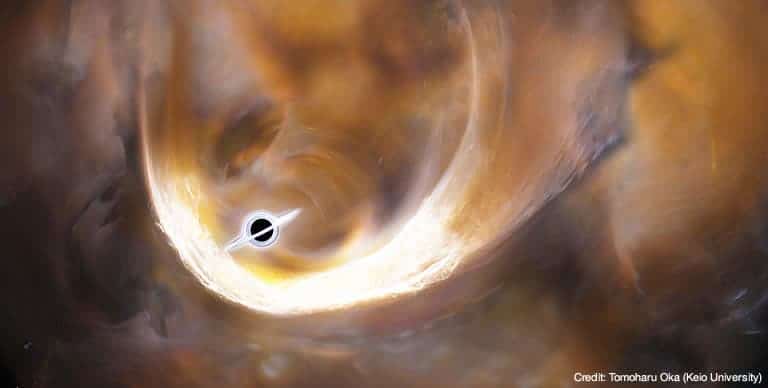Japanese astronomers may have discovered an intermediate black hole close to the center of our galaxy, the Milky Way. This finding could help explain how supermassive black holes form at the center of galaxies.

Credit: Tomoharu Oka (Keio University)
Most galaxies we know of have a supermassive black hole (SMBH) at their center. The name is pretty self explanatory – SMBHs are the largest type of black hole and the most massive thing in the known Universe, reaching billions of solar masses. Astronomers are very confident that our own Milky Way galaxy has a supermassive black hole at its center, 26,000 light-years from the Solar System, in a region called Sagittarius A*. But there may be another SMBH in the area.
Using the Nobeyama 45-m Radio Telescope, a team of astronomers led by Tomoharu Oka, a professor at Keio University in Japan, has found an enigmatic gas cloud, called CO-0.40-0.22, only 200 light years away from the center of the Milky Way. The gas is mysterious because it has a very wide velocity dispersion – in other words, it contains gas moving with very different speeds. There are no holes inside the gas, no visible object to exert a gravitational attraction and no sign of a recent supernova explosion. After eliminating all impossible solutions, researchers were left with a very surprising possibility: an invisible black hole.
“Considering the fact that no compact objects are seen in X-ray or infrared observations,” Oka, the lead author of the paper that appeared in the Astrophysical Journal Letters, explains “as far as we know, the best candidate for the compact massive object is a black hole.”
If this is indeed the case, it’s the first “intermediate” black hole we’ve ever found; up until now, we’ve only known small and very large black holes. Also, the study provides a very good way to study black holes indirectly – just study gas clouds and see if they do something strange.
“Investigations of gas motion with radio telescopes may provide a complementary way to search for dark black holes” said Oka. “The on-going wide area survey observations of the Milky Way with the Nobeyama 45-m Telescope and high-resolution observations of nearby galaxies using the Atacama Large Millimeter/submillimeter Array (ALMA) have the potential to increase the number of black hole candidates dramatically.”
Black holes are very difficult to study in any wave length, and this type of method would be much needed.
Journal Reference:
- Tomoharu Oka, Reiko Mizuno, Kodai Miura, Shunya Takekawa.SIGNATURE OF AN INTERMEDIATE-MASS BLACK HOLE IN THE CENTRAL MOLECULAR ZONE OF OUR GALAXY. The Astrophysical Journal, 2015; 816 (1): L7 DOI: 10.3847/2041-8205/816/1/L7






